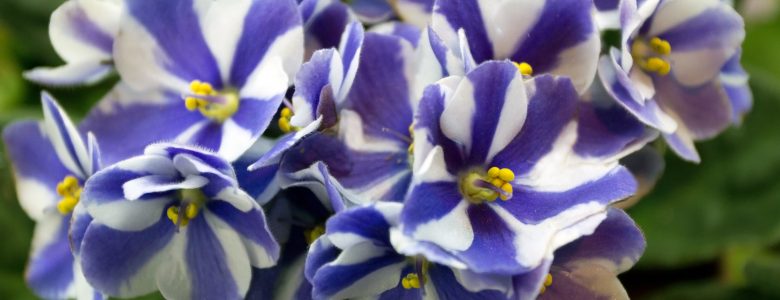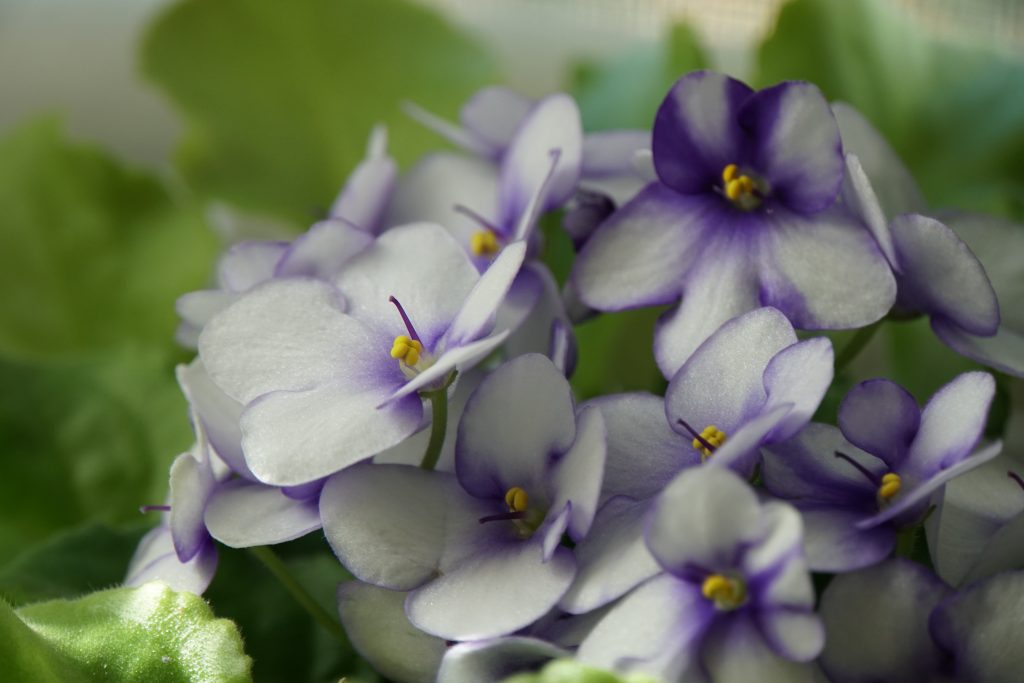May 20, 2020
African Violets: A Horticulturist’s Mutant Paradise

By: burgundy bug
Purple and white chimera African violet in bloom
Source: Adobe Stock
With showy blossoms ranging from blue to burgundy and white to green, it’s no wonder the African violet (Saintpaulia Ionantha) is among the most popular houseplants across the world.
When gazing upon these vibrant, vivacious “violets” with their pinwheel stripes or “fantasy speckles,” one can’t help but wonder, “How the hell did we get here?”
The answer lies in almost a century of hybridization, accented and accelerated by a few decades of chemical mutagens and radiation, according to a 2017 Folia Horticulturae review.
A Bit of Context…
“African Violet History:
Optimara African Violet Guide | MyViolet
It began just over 120 years ago as a lucky discovery in the mountains of Tanzania and has now become the world’s most popular houseplant.”
African violets were first discovered by Walter von Saint-Paul-Illaire in the mountains of Usambara, Tanzania in 1892, according to Optimara’s African Violet Guide.
That fall, African violet samples were sent to master gardener Hermann Wendland, who first described the flowers in Berlin’s botanical journal “Gartenflora” in 1893.
African violet illustrations by Hermann Wendland in 1893
Source: Garten Flora (1893) pg. 323 | Biodiversity Library
“Technically, the flower is not really a violet,” Optimara’s guide states. “Whereas the genus Viola derives from the Violaceae family, Saintpaulia belongs to the Gesneriad family.”
The First African Violet Hybrids
The roots of commercial African violet breeding run back to 1927, when the first 10 hybrids were introduced – all of which, sported blue flowers.
Read: The Science Behind Blue Flowers
The Burgundy Zine
The first commercial African violet cultivars are:
- Admiral
- Amethyst
- Blue boy
- Commodore
- Mermaid
- Neptune
- Norseman
- Number 32
- Sailor Boy
- Viking
Many of the African violet varieties known and distributed across the world today can be traced back to these original cultivars, Optimara says.
Achieving Rare African Violet Hybrids
African violet with “fantasy” blooms
Source: Adobe Stock
“In African violet, techniques such as the application of chemical mutagens, radiation, and colchicine have been successfully applied to induce mutants,” says the Folia Horticulturae review. “Among these techniques, γ radiation and colchicine have been the most commonly applied mutagens.”
Colchicine is a toxic chemical frequently used to induce polyploidy in plants, according to the International Carnivorous Plant Society.
“Basically, the colchicine prevents the microtubule formation during cell division, thus the chromosomes do not pull apart like they normally do,” the ICPS says. “The end result is a cell that now has double the number of chromosomes that it would normally have. If this cell divides again in the future, then the doubled number of chromosomes are passed to the offspring cells.”
Polyploidy is often used to enhance flower quality and enlarge the size of fruit, Medium reports. It’s a natural phenomenon that plant breeders have “played with quite extensively.”
Classical breeding – deliberately cross-pollinating two different cultivars – can produce offspring with a desired trait, but it limits breeders to the inherent properties the plants possess and can be subject to “poor combining,” the Folia Horticulturae review explains.
“Mutation breeding thus offers a solution to difficulties encountered in classical breeding,” the review says. “For example, if genes conferring undesirable characters are tightly linked to genes controlling desirable traits, then induction of mutations may result in a cross-over event or isolation for the desired trait.”
“Mutation breeding may be the only acceptable way of classically increasing variability in plant species that do not develop seeds, and to develop novel colors and variations in vegetative propagated ornamental plant species.”
African violet (Saintpaulia ionantha H. Wendl.): Classical breeding and progress in the application of biotechnological techniques | Folia Horticulturae
In African violets, such mutation techniques have been used to trigger leaf albinism and other vegetative pigmentation changes, altered leaf shapes, as well as changes in flower color patterns.
The Instability of Mutated African Violets
Although mutating African violets can produce significant changes to their appearance, these changes are difficult to maintain in future generations.
For example, African violets can produce offspring identical to the host plant by propagating one of its leaves, but the same can’t be done for African violets with chimera (“pinwheel striped”) flowers, The Violet Barn explains.
Read: Gardening Guides: How to Propagate an African Violet from a Leaf
The Burgundy Zine
The genetic makeup of each cell in an African violet leaf is usually identical. But in chimeras, each cell is genetically unique.
“Because of this, plants produced from [chimera] leaf cuttings frequently are not identical to the plant from which the cutting was taken,” The Violet Barn says.
Instead, the most effective way to propagate a chimera and keep those mutations is to propagate the plant’s crown and suckers. Even then, it’s not guaranteed that every single sucker will produce chimera blooms.
Additionally, chimeras are notoriously inconsistent. After a few bloom cycles, the dominant color will overtake the flower and the appearance of stripes will disappear, as demonstrated by the first study of mutant-induced color changes in an African violet.
Even if the bi-color appearance remains, the pattern in which they appear might change.
These African violets were originally purple and white chimeras, and after the first three bloom cycles, they have consistently produced white flowers with traces of purple around the edges for the last five years.
(Left to right) Chimera African violets after five years of blooming. Photographs taken in Sept. 2019, Jan. 2020, and March 2020
Source: African Violets | Penelope Peru Photography
To add insult to injury, African violets are highly sensitive to their environment, the University of Vermont explains. Overwatering, exposing the leaves or crown to water, and too much or too little light, can all lead to poor quality of life for the plant.
These sensitive properties can also affect a breeder’s ability to produce consistent results among their cultivar. To which, the Folia Horticulturae review suggests genetic engineering could remedy by improving African violets’ tolerance to environmental stressors.
“Plants resistant to biotic and abiotic stresses will need to be developed using transgenic strategies, and this requires robust and reproducible genetic engineering and tissue culture protocols to regenerate transformants,” the review says. “These techniques are now available.”
In Conclusion
“Despite the large palette of colors available amongst African violet varieties, there are still color modifications that would be very valuable in Saintpaulia and which can only be achieved through genetic engineering.”
African violet (Saintpaulia ionantha H. Wendl.): Classical breeding and progress in the application of biotechnological techniques | Folia Horticulturae
African violets have won the hearts of horticulturists, botanists, and casual gardeners alike throughout the last century due to their striking appearance and variability.
Naturally, consumerism has encouraged breeders to keep striving for rarer and rarer African violet cultivars. Thus, breeders have used mutation techniques to free themselves from the shackles of classical breeding and the plant’s natural genetic makeup.
Technologically, other genetic modification strategies are more widely available now, such as genetic engineering. African violets could be a candidate for genetic engineering in the future due to their high-commercial value and perceived “need” for newer traits.
“However, to date, transgenic varieties of African violet have not been commercialized,” the review says. “Given the complexity of the regulatory process associated with the release of transgenic plants, our expectation is that conventional breeding methods, including mutagenesis, will thus continue to dominate the product pipeline for African violet.”
Grow Your Own African Violets
Are your green thumbs wriggling after reading all this plant talk? Head on over to our gardening guides to learn more about propagating and caring for your own African violet!
Interested in having content featured in an upcoming blog post or issue of The Burgundy Zine? Head on over to the submissions page!
Interested in working with Burgundy Bug? Learn more about commissioning her writing and art here!
For all other inquiries, please fulfill a contact form.








